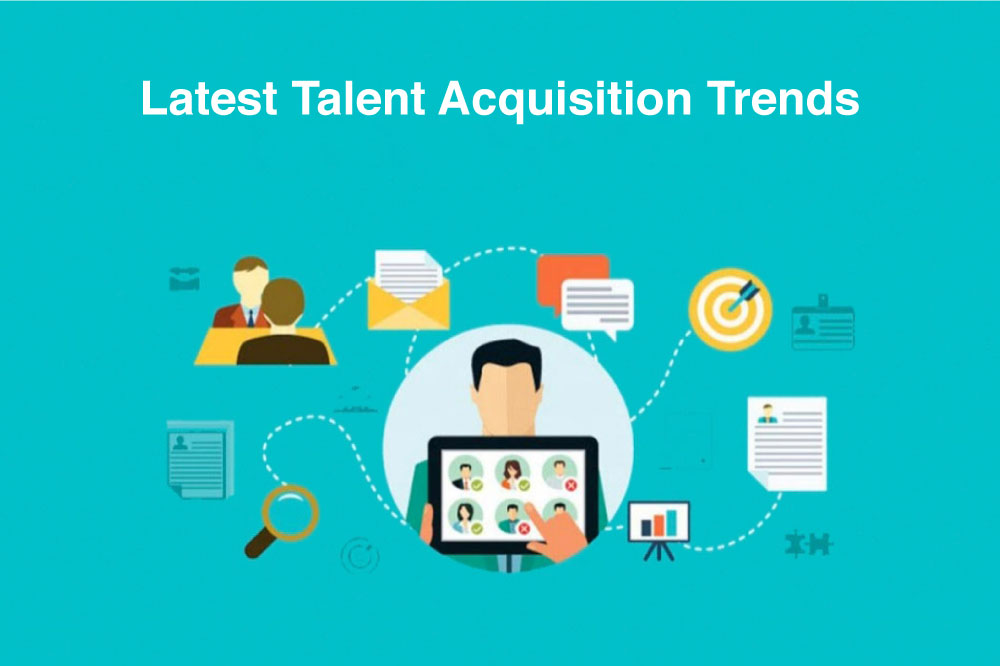Latest Talent Acquisition Trends

Talent acquisition is a critical aspect of the recruitment process in today’s highly competitive talent market. Staying up-to-date on these trends is essential for success. One of the most valuable skills for recruiters is the ability to source high-quality candidates. It’s a challenging task that often requires a creative approach to hiring. To achieve this, recruiters must adapt to new talent acquisition trends, which include leveraging technology, embracing data-driven strategies, prioritizing personalization, and exploring the potential for automation in the recruitment process. By understanding and incorporating these trends, HR and recruitment teams can enhance the efficiency and effectiveness of their hiring efforts, ultimately ensuring they attract the best candidates for their organization.
For that, some of the following effective recruitment trends will help in improving your recruiting process.
Talent acquisition trends to improve the recruitment process
1. Recruitment marketing
Recruitment marketing is the use of various strategies and tactics to attract and engage job seekers. The goal is to encourage potential applicants to apply for job openings, which can be achieved through different channels such as social media, job boards, emails, digital advertising, and newsletters.
Organizations can use this to improve their reputation as employers, connect with potential employees, and make their career sites more efficient. Additionally, recruitment marketing can help to create a positive candidate experience, which can increase the likelihood of a successful hire.
2. Artificial intelligence
Going through resumes by hand is still the most tedious aspect of recruiting. It is estimated that it takes a recruiter 23 hours to go through resumes and select the right candidates for an interview for one position.
AI for recruiting is a great advantage for recruiters if it can automate laborious and repetitive tasks such as examining resumes and organizing interviews with applicants. It assists in finding the best fit between candidate and job through pre-screening, tracking, and recruitment using current analytics. It saves recruiters time by taking care of the high-volume task automatically.
AI chatbots are a useful tool for gathering a large amount of candidate information in place of human interaction. This automation process helps to reduce the amount of manual labor required for recruiting. The Applicant Tracking System (ATS), Crowdsourcing, Referrals, and other job-related applications are now working more efficiently due to this technology.
The success of recruiters in the future will be determined by their ability to analyze data, recognize patterns, and understand natural language. Technology is making it easier for recruiters to reduce the amount of manual labor involved in the hiring process and enhance the experience for both employers and candidates.
3. Employer branding
Employer branding is a popular method of finding qualified employees. Businesses need to utilize this strategy to remain competitive and powerful in the business world. This strategy can help to attract the best talent and keep them in the company, which will be beneficial for both the team and the company.
Having a strong online presence helps to raise recognition of your brand, which is beneficial for your business. You can demonstrate your company culture and show potential employees what it’s like to work for your organization. An effective employer branding strategy not only assists in drawing job seekers but also decreases the amount of time needed to fill a vacancy.
4. Candidate experience
The Candidate experience is determined by the emotions, behaviors, and opinions that job seekers have throughout the recruitment process, which includes finding candidates, screening them, interviewing them, hiring them, and finally onboarding them.
Nowadays, when looking for a job, applicants are not only interested in what benefits a company provides but also the goals it strives for and the atmosphere it creates. Showing job seekers a great experience will help create a positive perception of the company. Furthermore, encouraging job candidates to share their experiences on social media can help build a consistent image of the company and maintain a good reputation.
5. Social media recruiting
Social media networks and websites can be used to search for, draw in and hire talented people. This process is known as recruiting through social media channels. Examples of these networks and websites include Facebook, Twitter, LinkedIn, blogs, forums, job boards and Glassdoor.
Platforms such as Facebook, Twitter, and LinkedIn, as well as websites such as blogs, forums, job boards, and Glassdoor can be useful tools for finding the right personnel. These can be used to locate, attract, and hire the best people for the job.
Participating in LinkedIn groups and using hashtags are excellent methods to expose your job openings to potential applicants. You should also post content that demonstrates why your company is a great place to work, so you can naturally draw in candidates.
Recruiters can use filters to locate potential job seekers. This includes searching by their location, previous and current employers, and the amount of experience they have. This way, recruiters can find people who have the right skills and will be a good fit for their organization.
Additionally, you can cut costs by recruiting through social media, unless you advertise job openings through paid ads.
6. Background verification and assessment technology
In the past, employee background checks were a lengthy and costly process usually handled by external organizations. AI and machine learning technology are now making the process of employee background checks faster, more intelligent, and more successful.
Nowadays, digital fraud is increasing, so recruiters need to utilize background screening technology to prevent wasting their precious time. Moreover, since background evaluation is intricate, lengthy, and multi-leveled, it is a great opportunity to apply Artificial Intelligence.
7. Talent pool
Talent pool is a collection of job candidates stored in ATS by recruiters and HR Managers. It is organized according to the candidates’ abilities and location. It includes not just those who applied for jobs, but also those who were referred, those who weren’t chosen for the job, and those who chose to join the pool.
The goal of having a talent pool is to make the process of finding the right person for a job quicker and easier. Many recruiters are taking advantage of this recruitment trend and creating a database of potential candidates for present and future positions.
8. Go mobile
A study reveals that nearly half of job seekers use their mobile phones daily to search for employment, and a significant portion of them, one-sixth, submit applications via mobile. Smart recruiters enables the creation of branded, mobile-optimized career pages, attracting better-quality candidates.
To enhance selection efficiency, engaging potential candidates through mobile devices and incorporating it into your recruitment plan expedites hiring. The right app streamlines team collaboration, reduces time-to-hire, and improves the candidate experience. Staying updated on recruitment trends and optimizing strategies is essential for staying competitive in the industry.
9. Internal recruiting
Internal recruiting can be a great way to tap into the talent pool already within an organization. It can be a cost-effective solution as well, as there is no need to pay for external recruiting services. Additionally, internal recruiting can help to create a sense of loyalty and commitment among existing employees, as they may be more likely to refer to qualified candidates that they know and trust.
Companies like Schneider Electric take a much more proactive approach. The company launched an AI-powered internal mobility platform based on data that 47% of people leaving the company couldn’t find another appealing internal role. Employees create profiles that include their aspirations, skills and interests and receive suggestions not only for full-time roles, but projects, training, mentoring opportunities and more.
10. Webinars
Webinars are an increasingly popular tool for recruiters to connect with potential candidates. Through webinars, recruiters can present their company and the job opportunity to a large group of potential candidates without having to physically meet with each one. This allows recruiters to save time and money, while still engaging with a large audience.
Webinars also allow recruiters to interact with potential candidates in real-time, creating a more dynamic and engaging experience. For instance, the International Atomic Energy Agency hosted a webinar for women interested in careers in the nuclear field. The speakers shared information about their current projects and provided advice on career paths.
11. Flexibility and adaptability
In today’s competitive job market, recruiters must possess the qualities of flexibility and adaptability. They need diverse resources and tools to swiftly identify and recruit ideal candidates for specific roles. Being able to adjust strategies as company needs and market demands evolve is crucial for consistently sourcing top-tier candidates.
Moreover, agility is vital for recruiters. This includes strategically recruiting temporary workers and contractors to navigate financial uncertainties and market changes while maintaining business operations. A significant 70% of executives expect increased reliance on temporary and contract workers this year.
12. Diversity, equity and inclusion (DEI)
In the modern workforce landscape, fostering diversity, equity, and inclusion (DEI) is crucial. To ensure an equitable candidate pool, companies should implement equal opportunity policies, offer comprehensive diversity training, and collaborate with minority-owned businesses. This commitment to DEI is vital for job seekers, and many inquire about an organization’s efforts. The importance of diversity in hiring is growing, with companies like Starbucks setting specific DEI recruiting goals. Crafting inclusive job descriptions, diversifying interview panels, and measuring DEI progress can help attract and hire more diverse candidates, contributing to a more inclusive talent acquisition process.
Conclusion
In this dynamic landscape of talent acquisition, staying ahead of the curve is crucial for success. The trends we’ve explored, from recruitment marketing to AI, employer branding, candidate experience, and more, all play a pivotal role in shaping the future of talent discovery and acquisition. As organizations adapt to evolving job markets and changing candidate expectations, the ability to remain flexible and committed to diversity, equity, and inclusion (DEI) becomes paramount.
Centizen Talent Hub is the key to building a dedicated remote team for your business. Get started today!
Centizen
A Leading IT Staffing, Custom Software and SaaS Product Development company founded in 2003. We offer a wide range of scalable, innovative IT Staffing and Software Development Solutions.
Contact Us
USA: +1 (971) 420-1700
Canada: +1 (971) 420-1700
India: +91 86107-03503
Email: contact@centizen.com
Our Services
Software Development
IT Staffing
General Staffing
Remote Hiring
Products
Contact Us
USA: +1 (971) 420-1700
Canada: +1 (971) 420-1700
India: +91 86107-03503
Email: contact@centizen.com






